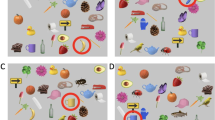Abstract
Investigation on illusory contours is important for understanding the mechanisms underlying the object recognition of human visual system. Numerous researches have shown that illusory contours formed in motion and stereopsis are generated by the unmatched features. Here we conduct three psychophysical experiments to test if Kanizsa illusory contours are also caused by unmatched information. Different types of motion (including horizontal translation, radial expanding and shrinking) are utilized in the experiments. The results show that no matter under what kind of motion, when figures or background move separately illusory contours are perceived stronger, and there is no significant difference between the perceived strength in these two types of motion. However, no such enhancement of perceived strength is found when figures and background move together. It is found that the strengthened unmatched features generate the enhancement effect of illusory contour perception in motion. Thus the results suggest that the process of unmatched information in visual system is a critical step in the formation of illusory contours.
Similar content being viewed by others
References
Kanizsa, G., Subjective contours, Scientific American, 1976, 234: 48–52.
Schumann (1904) Einige Beobactungen uber die Zusammenfassung von Gesichtsendrucken zu Einheiten translation by A Hogg, Some observations on the combination of visual impressions into units, in The Perception of Illusory Contours (eds. Petry, S., Meyer, G.), New York: Springer, 1987, 21–34.
Kanizsa, G., Quasiperceptual margins in homogeneously stimulated fields (translated by Gerbino, W.), in The Perception of Illusory Contours (eds. Petry, S., Meyer, G. E.), New York: Springer, 1987, 40–49.
Peterhans, E., Von der Heydt, R., Subjective contours-bridging the gap between psychophysics and physiology, Trend in Neuroscience, 1991, 14: 112–119.
Liu, L., Stevenson, S. B., Schor, C. M., Quantitative stereoscopic depth without binocular correspondence, Nature, 1994, 367: 66–69.
Gillam, B., Nakayama, K., Quantitative depth for a phantom surface can be based on cyclopean occlusion cues alone, Vision Research, 1999, 39: 109–112.
Nakayama, K., Shimojo, S., Da Vinci stereopsis: depth and subjective occluding contours from unpaired image points, Vision Research, 1990, 30: 1811–1825.
Shimojo, S., Nakayama, K., Interocularly unpaired zones escape local binocular matching, Vision Research, 1994, 34: 1875–1881.
Shimojo, S., Silverman, G. H., Nakayama, K., Occlusion and the solution to the aperture problem for motion, Vision Research, 1989, 29: 619–626.
Anderson, B. L., The role of partial occlusion in stereopsis, Nature, 1994, 367: 365–368.
Anderson, B. L., Stereoscopic occlusion and the aperture problem for motion: A new solution, Vision Research, 1999, 39: 1273–1284.
Anderson, B. L., Julesz, B., A theoretical analysis of illusory contour formation in stereopsis, Psychophysical Review, 1995, 102: 705–743.
Anderson, B. L., Sinha, P., Reciprocal interactions between occlusion and motion computations, Proceedings of the National Academy of Sciences, 1997, 94: 3477–3480.
Anderson, B. L., Barth, H. C., Motion-based mechanisms of illusory contour synthesis, Neuron, 1999, 24: 433–411.
Malik, J., Anderson, B. L., Charowhas, C., Stereoscopic occlusion junctions, Nature Neuroscience, 1999, 2: 840–843.
Anderson, B. L., Nakayama, K., Toward a general theory of Stereopsis: Binocular matching, occluding contours, and fusion, Psychological Review, 1994, 101: 414–445.
Kellman, P. J., Cohen, M. H., Kinetic subjective contours, Perception & Psychophysics, 1984, 35: 237–244.
Kellman, P. J., Loukides, M. G., An object perception approach to static and kinetic subjective contours, in The Perception of Illusory Contours (eds. Petry, S., Meyer, G.), 1987, New York: Spinger, 151–164.
Banton, T., Levi, D. M., The perceived strength of illusory contours, Perception & Psychophysics, 1992, 52: 676–684.
Dumais, S. T., Bradley, D. R., The effects of illumination level and retinal size on the apparent strength of subjective contours, Perception & Psychophysics, 1976, 19: 339–345.
Bradley, D. R., Cognitive contours and perceptual organization, in The Perception of Illusory Contours (eds. Petry, S., Meyer, G.), 1987, New York: Springer.
Dresp, B., Lorenceau, J., Bonnet, C., Apparent brightness enhancement in the Kanizsa square with and without illusory contour formation, Perception, 1990, 19: 483–489.
Lesher, G. W., Mingolla, E., The role of edges and line-ends in illusory contour formation, Vision Research, 1993, 33: 2253–2270.
Shimojo, S., Kamitani, Y., Nishida, S., Afterimage of perceptually filled-in surface, Science, 2001, 293: 1677–1680.
Ringach, D. L., Shapley, R., Spatial and temporal properties of illusory and amodal boundary completion, Vision Research, 1996, 36: 3037–3050.
Bruno, N., Gerbino, W., Illusory figures based on local kinematics, Perception, 1991, 20: 259–274.
von der Heydt, R., Peterhans, E., Baumgartner, G., Illusory contours and cortical neuronal responses, Science, 1984, 224: 1260–1262.
von der Heydt, R., Peterhans, E., Mechanism of contour perception in monkey visual cortex (I)-Lines of pattern discontinuity, Journal of Neuroscience, 1989, 9: 1731–1738.
Zhou Yifeng, Jia Fan, Tao Haiyang et al., The responses to illusory contours of neurons in cortex areas 17 and 18 of the cats, Science in China, Ser. C, 2000, 30(6): 660–668.
Peterhans, E., von der Heydt, R., Mechanisms of contour perception in monkey visual cortex (II)-Contours bridging gaps, Journal of Neuroscience, 1989, 9: 1749–1763.
Li Chaoyi, Guo Kun, Measurements of geometric illusions, illusory contours and stereo-depth at luminance and color contrast, Vision Research, 1995, 35: 1713–1720.
Sheth, B. R., Sharma, J., Rao, S. C. et al., Orientation maps of subjective contours in visual cortex, Science, 1996, 274: 2110–2115.
Nakayama, K., Shimojo, S., Experiencing and perceiving visual surfaces, Science, 1992, 257: 1357–1363.
Kourtzi, Z., Kanwisher, N., Representation of perceived object shape by the human lateral occipital complex, Science, 2001, 293: 1506–1509.
Author information
Authors and Affiliations
Corresponding author
Rights and permissions
About this article
Cite this article
Ni, R., Wang, Z., Wu, X. et al. Perception of illusory contours enhanced in motion. Sci. China Ser. C.-Life Sci. 46, 570–583 (2003). https://doi.org/10.1360/03yc0106
Received:
Issue Date:
DOI: https://doi.org/10.1360/03yc0106




